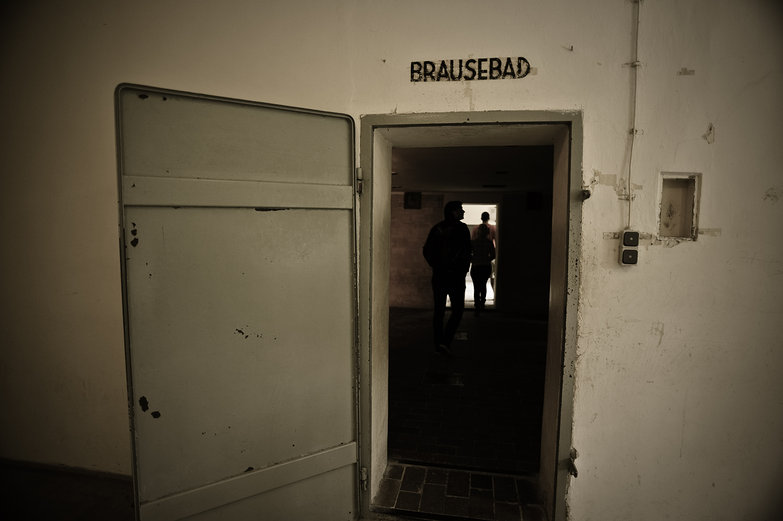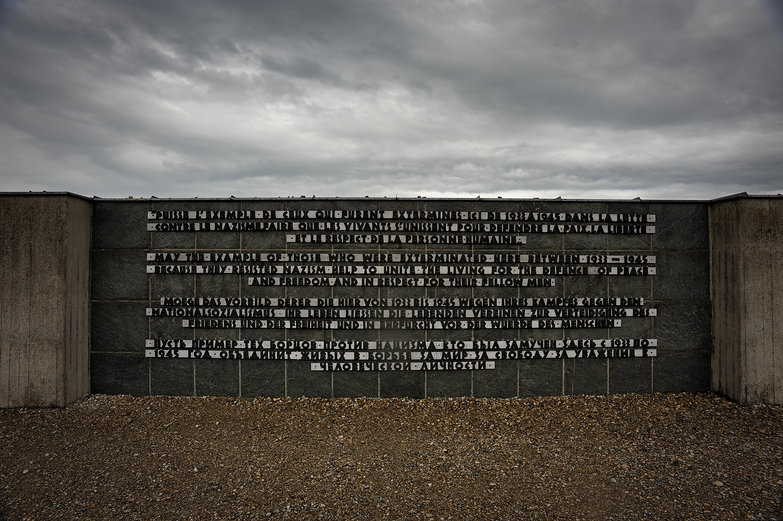I'm not sure what I was expecting when we decided to visit Dachau Concentration Camp. I can, however, say one thing for certain: I was in no way prepared for the enormity of the memorial. We spent over six hours reading the exhibits before we were both too overwhelmed to continue. When we stopped, equal parts depressed and outraged by the depravity, there was still much to see.

We arrived just before the 5PM closing of the site yesterday. Rather than rushing ourselves, we decided to camp in a hidden spot near the car park. Wanting to do the memorial justice, we planned to start the following morning.

The last few weeks have been full of rain. The chain of bad weather was unbroken today. Perhaps aptly so. Dachau is not a sunny place.

Our time in Dachau began in the same manner as each prisoner who was enslaved there, by passing through a metal gate with the ironic words "Work Will Set You Free" above the doorway.

As a light drizzle fell from the sky, we entered the courtyard, already haunted by a faint knowledge that this declaration was mortally true for most of the inhabitants. Over the next six hours, our glimmer of understanding about what happened in concentration camps would become crystal clear.

Death was the only escape for most at Dachau, the only true freedom. Forced to work ceaselessly until the harrowing mission statement of their unthinkable confinement became a reality, their eventual and intentional extermination through work and abuse was quite seriously, part of the plan.
We started our visit in "The Bunker", home to Dachau's so-called special prisoners.

Many high level enemies of the state like Georg Elser (who tried to assassinate Hitler) were incarcerated separately from the general population here.

Other less assuming victims were imprisoned for insane reasons, like having the audacity to complain about the censorship of their mail.

One of the first in a unending string of atrocities we would read about over the course of our day were the "standing cells" built in the bunker. These were 2 1/2 foot square cages made of wood. Prisoners were placed in them for 72 hours with nothing but bread and water (if they were lucky), unable to sit or move for the duration of the punishment.

On the fourth day, they were released to sleep, and often forced to return the following morning, starting the process anew.

We spent the majority of our day in the former service building. The structure, which must be at least a football field in length, is completely full of exhibits. They document everything from the lead up to the war, to the eventual rescue of Dachau's remaining inhabitants, to stories and photos of the survivors up to the present day.

It has been at least a decade, if not more, since I read much of anything about World War II. I was thankful for the thoroughness of the memorial. The beginning of the exhibits explained in detail how the National Socialist German Workers' Party organized, their usage of propaganda, and the social climate that engendered their rise to power.
Though I won't attempt to re-create the explanation (as I would likely not do it justice), it was chilling to once again be faced with the reality that civilization itself is held together by a very tenuous thread.

Moving past Dachau's creation, the memorial went on to explain everything from daily life in the camp, to the system of training one of the commanders there, Theodor Eicke, employed. His goal was to create relentless, ruthless guards out of his men. His philosophy culminated in the phrase "tolerance is weakness"; his officers knew no mercy for the prisoners they kept. There was even a term for it: the "Dachau spirit", and those who had it were sent to concentration camps all over Europe to spread this hatred further.
One practice invented at Dachau was "roll call" which happened at a minimum twice a day, once in the morning and once in the evening. All prisoners were required to stand at attention, perfectly still. If anyone moved, they were beaten, often killed. In winter, prisoners were frequently required to stand at roll call naked. For hours. In summer, they were forced to do so in heavy coats.

Besides enforcing pointless tasks like carrying heavy rocks back and forth with no purpose, the guards also played cruel "games" with the prisoners. One of which involved the death line around the camp. Surrounding the border of Dachau, there was a ditch, after which there was a fence. Should any prisoner cross the line into the ditch, he would be shot on sight.

Guards would steal a prisoner's hat, and throw it into the ditch. Then, they would order them to retrieve it. If they didn't, they were killed. If they did, they were killed. The atrocities went on, and on, and on.
Scientific experiments performed on prisoners: submerging them in ice cold water to see which organs would fail first, restricting liquid intake to seawater only to document the results, high pressure studies which resulted in brain embolisms, and much, much more. For hours we read and read, looked at photos, watched videos, and shook our heads in horror.
Jews, Christians, Germans, Poles, French, Russians, Czech, educated people, homeless people, politicians, travelers, Gypsies, prisoners of war, gay people, straight people, brave people who dared speak out, meek people who said the wrong thing, and more… all of them were reduced to this:

This could have been me. No, it most certainly would have been. Tara too. Neither of us would have fit the societal "norm" required to escape persecution. Not remotely.
"How could this happen?" we thought to ourselves, time and time again. The answer was revealed when we saw how newspapers portrayed the camp. The guards would force prisoners to keep portions of the site pristine and tidy.
When reporters, foreign tourists, or government officials came, all looked like a humane factory full of workers. Prisoners were vilified, portrayed as lazy criminals who needed to be feared, disciplined, and taught the value of work.
The last part of our visit was seeing the crematorium, and walking through the gas chamber. At the entrance is a memorial that says, "Dachau Crematorium: Think on how we died here."
There was a gas chamber, disguised as a shower, complete with fake nozzles on the ceiling. Brausebad = Shower.

It was heavy and haunting, horrifying and overwhelming. For unknown reasons, the gas chamber at Dachau was never actually used for mass exterminations like at Auschwitz.

…just for murdering individuals and small groups.
For a very long time, no one knew what was happening. Not even people who lived nearby. Neighbors did not know about the death and torture occurring until the end of the war when the ovens were too full, and corpses had piled up, creating a foul smell.

The truth was only revealed when American troops came along, and under orders from the president, made as many of the citizens as possible visit the camp.

Even with the war over, the horror didn't end. Many of the survivors were not met with compassion, but instead disgust.

One of the many heartbreaking things about this place, was that on top of all the suffering that went on here, it took a lot of effort to memorialize it. Victims had to band together to fight that the memories be preserved, and after many, many years, they were finally successful.
For people who are in emotional turmoil over everything seen here, there is a chapel. It is fittingly austere and dark, yet still peaceful.
It was overwhelming, being here.

The most gut wrenching part of all of this, for me, is the knowledge that genocide is not yet a mere part of humanity's violent and decorated history. This sort of thing is still going on around the world. Right now. In just the last few years, people have been killed en mass in places like Darfur, Burundi, Congo and more.
A website called Genocide Watch tries to raise awareness about this fact. I knew all of this before we visited Dachau, but it isn't something one generally thinks about on a daily basis. Maybe it should be. We live in a world where such a thing as "Genocide Watch" needs to exist. Talk about a change in perspective.

For an exhaustively thorough look at Dachau Concentration Camp, please visit this excellent website.










